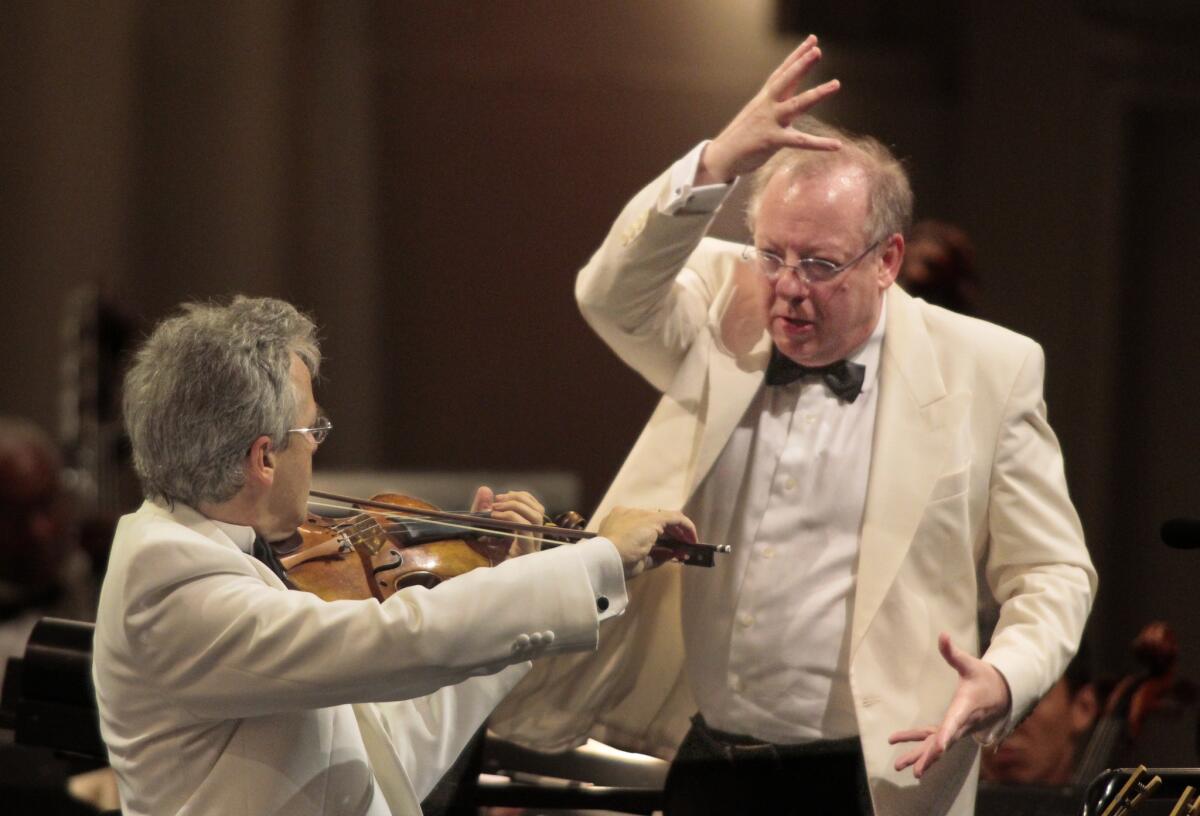Review: At Hollywood Bowl, Nicholas McGegan is the man for all seasons

- Share via
The Hollywood Bowl this summer seems to be taking few chances by playing favorites. Leaving adventure to the other Los Angeles Philharmonic seasons in Walt Disney Concert Hall, otherwise adventurous conductors and performers have leaned heavily on top of the classical pops (and sometimes just pops).
That has meant a summer dominated by the overexposed (however great) likes of Beethoven’s Fifth Symphony (played brilliantly) by Gustavo Dudamel, Tchaikovsky’s First Piano Concerto for Esa-Pekka Salonen (he canceled), Bramwell Tovey’s “Rhapsody in Blue,” Leonard Slatkin’s “Scheherazade” and Joshua Bell’s “Eleanor Rigby.”
And Tuesday, Nicholas McGegan arrived at the Bowl for an evening devoted to two evergreen front-runners of the Baroque Hit Parade: Vivaldi’s “The Four Seasons” and Handel’s “Water Music.” But thankfully, he had tricks up his sleeve.
The seasons were, as McGegan amusingly told the audience, all mixed up, like California weather. With L.A. Phil concertmaster Martin Chalifour as soloist, five individual movements from Vivaldi’s seasons were interwoven with three of tango master Astor Piazzolla’s “The Four Seasons of Buenos Aires.”
Mixing up everything all the more were Leonid Desyatnikov’s arrangements for solo violin and strings of Piazzolla’s pieces originally for the bandoneon player’s Argentine tango band. Desyatnikov not only created a virtuoso violin part but also added sly Vivaldi quotes and arresting instrumental effects on string instruments to mimic raspy percussion and sexy bandoneon banter. The result is a postmodern tango treat, true to the spirit of everybody — Piazzolla’s Buenos Aires, Vivaldi’s Venice and Desyatnikov’s radical post-Shostakovichian Moscow.
Finally, add to this mixed-up mix McGegan and Chalifour. The British founder and longtime leader of the Philharmonic Baroque in the Bay Area, McGegan is a specialist in early music period practice. His Vivaldi is properly lean, spry and luminous without wiggly vibrato. But what’s a tango without wiggle and juice? And what’s Russian music without throbbing strings and juice?
Meanwhile, Chalifour is a stylistic chameleon, an elegant player adaptable to any kind of music, a necessity, of course, being concertmaster of the world’s most versatile major orchestra. Still, it must have been a stretch for him to go from delicately ornamenting Vivaldi to seductive tango.
But he did and with an engaging suavity. McGegan, who makes everything he conducts look as if it’s more fun than anything, simply jumped in, and Chalifour and the small string orchestra had no choice but to follow.
Somehow, despite minimal rehearsal time, McGegan achieved a reasonable facsimile of the sound of period instruments in Vivaldi and something a little racier in the Piazzolla/Desyatnikov.
More important, Chalifour and McGegan avoided making the mix a mess.
Vivaldi and Piazzolla had much in common, such as an exhilarating rhythmic facility, the technique to make complex counterpoint sizzle and a love of alluring sound effects. But what joins them most is their respective gifts for the heart-rending melody.
At the end of the 35-minute set, Vivaldi’s extraordinarily beautiful melancholy of winter was, thus, allowed to turn, turn, turn to Piazzolla’s wistful renewal of spring, and rather than mixed-up seasons in globally warmed times, there was the bigger, better message that to everything there is — or at the very least, can be — a season.
For Handel’s “Water Music,” McGegan did some more fashioning, but only slightly. He played the First Suite in D, without the final two movements. He followed with the Second Suite in F, with the first two movements, instead in D, and without trumpets (choosing an earlier version than normally used).
The small orchestra of strings, oboes, bassoon, brass and harpsichord was on its toes. And if the ensemble wasn’t always perfect, the more important spirit did not flag.
Not only are the seasons mixed up in California, but we dream of water. Had the L.A. Phil been in a socially conscious mood, it might have employed the video monitors to accompany this “Water Music” with another seasonal message by showing images of drought and warnings about conservation.
Instead, they concentrated on McGegan showing pleasure in every phrase he conducted and an orchestra looking (and sounding) like being on its toes was its only fancy. That’s a message, too.
More to Read
The biggest entertainment stories
Get our big stories about Hollywood, film, television, music, arts, culture and more right in your inbox as soon as they publish.
You may occasionally receive promotional content from the Los Angeles Times.











